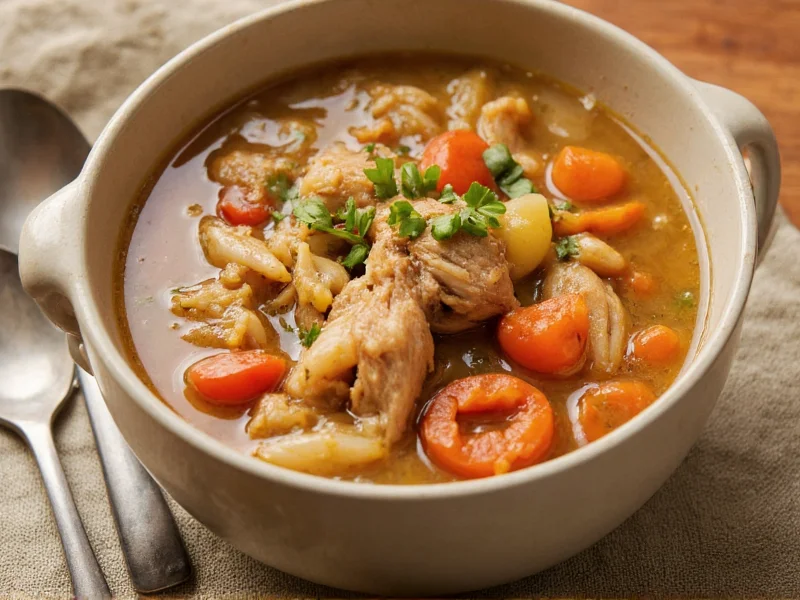Why Rotisserie Chicken Transforms Homemade Soup
Rotisserie chicken offers a remarkable shortcut for creating restaurant-quality chicken soup without hours of simmering. The pre-cooked meat provides immediate depth of flavor while the bones still contain collagen that enriches your broth during the brief simmering process. Professional chefs have long recognized this technique as one of the best-kept secrets for efficient soup preparation.
Essential Ingredients for Perfect Rotisserie Chicken Soup
Creating exceptional chicken soup with rotisserie chicken requires thoughtful ingredient selection. The quality of your components directly impacts the final result. Here's what you'll need for a classic version serving 6-8 people:
| Ingredient | Quantity | Preparation Notes |
|---|---|---|
| Rotisserie chicken | 1 (2-3 lb) | Remove meat from bones; reserve both |
| Chicken broth | 8 cups | Low-sodium preferred for better control |
| Carrots | 3 medium | Diced 1/4-inch for even cooking |
| Celery | 3 stalks | Include leaves for extra flavor |
| Yellow onion | 1 medium | Finely diced |
| Garlic | 3 cloves | Minced |
| Fresh thyme | 1 tbsp | Or 1 tsp dried |
| Bay leaves | 2 | Remove before serving |
| Egg noodles | 2 cups | Or rice for gluten-free option |
Step-by-Step Preparation Guide
Follow these professional techniques to maximize flavor while minimizing effort in your rotisserie chicken soup preparation:
1. Proper Meat and Bone Separation
Carefully remove all meat from the rotisserie chicken, separating white and dark meat. Place the meat in a bowl and cover. Transfer the bones to a large stockpot. This separation ensures optimal texture in your final soup.
2. Building Flavor Foundation
Add the chicken bones to your stockpot with 8 cups of broth, 1 bay leaf, and half of your vegetables. Simmer uncovered for 20 minutes. This brief simmer extracts maximum flavor from the bones without overcooking the already-cooked meat.
3. Vegetable Sauté Technique
While the bones simmer, heat 2 tablespoons of olive oil in a separate pan. Sauté onions, carrots, and celery over medium heat until translucent (about 8 minutes). Add minced garlic and cook for 1 additional minute. This step develops complex flavors through the Maillard reaction.
4. Final Assembly
Remove bones from the broth using a slotted spoon. Add the sautéed vegetables, reserved chicken meat, thyme, and noodles to the broth. Simmer gently for 15-20 minutes until noodles are tender. Avoid boiling vigorously to prevent chicken from becoming tough.
Proven Flavor Enhancement Strategies
Professional chefs employ these techniques to elevate rotisserie chicken soup from good to exceptional:
- Lemon juice finish: Add 1-2 tablespoons of fresh lemon juice just before serving to brighten flavors
- Herb bouquet: Tie fresh parsley, dill, and thyme with kitchen twine and simmer in the broth
- Umami boost: Include 1 tablespoon of tomato paste during vegetable sautéing
- Texture contrast: Reserve some chicken pieces for adding at the very end to maintain tenderness
Storage and Reheating Best Practices
Proper storage maintains quality and safety of your homemade soup:
- Cool soup within 2 hours of preparation
- Store in airtight containers for up to 4 days in the refrigerator
- Freeze in portion-sized containers for up to 3 months
- Reheat gently on the stove over medium-low heat
- Never boil reheated soup as this toughens the chicken
Popular Variations for Different Dietary Needs
Adapt this versatile base recipe to accommodate various preferences:
Gluten-Free Version
Substitute egg noodles with cooked rice, quinoa, or gluten-free pasta. Add these ingredients just before serving to prevent mushiness.
Low-Sodium Option
Use homemade broth or low-sodium store-bought varieties. Enhance flavor with extra herbs, lemon zest, and a splash of apple cider vinegar instead of salt.
Vegetable-Packed Soup
Add 1 cup each of diced zucchini, green beans, and peas during the last 10 minutes of cooking for increased nutrition without compromising flavor.
Troubleshooting Common Issues
Resolve these frequent challenges when making rotisserie chicken soup:
Soup Tastes Bland
Solution: Add acid (lemon juice or vinegar) and salt in small increments. The acid brightens flavors while salt enhances perception of taste.
Broth Appears Greasy
Solution: Chill the soup briefly, then skim fat from the surface with a spoon. Alternatively, use a fat separator when transferring broth to your cooking vessel.
Chicken Becomes Tough
Solution: Add pre-cooked chicken during the last 5 minutes of cooking. Over-simmering already-cooked chicken causes protein fibers to tighten and become rubbery.
Nutritional Benefits of Rotisserie Chicken Soup
This comforting dish offers significant nutritional advantages when prepared thoughtfully:
- High protein content from both meat and broth collagen
- Hydrating properties from the broth base
- Essential vitamins from added vegetables
- Electrolytes that support hydration
- Easy digestion compared to heavier meals
One serving (1.5 cups) typically contains approximately 250-300 calories, 20g protein, and valuable nutrients from the vegetables and herbs. The collagen-rich broth supports joint health and gut integrity, making this more than just a comforting meal.
Seasonal Adaptation Tips
Adjust your rotisserie chicken soup recipe throughout the year for optimal freshness:
- Spring: Add fresh peas, asparagus, and dill
- Summer: Incorporate zucchini, corn, and fresh basil
- Autumn: Include sweet potatoes, kale, and sage
- Winter: Add parsnips, turnips, and rosemary
Using seasonal produce not only enhances flavor but also provides peak nutritional value and supports local agriculture.











 浙公网安备
33010002000092号
浙公网安备
33010002000092号 浙B2-20120091-4
浙B2-20120091-4